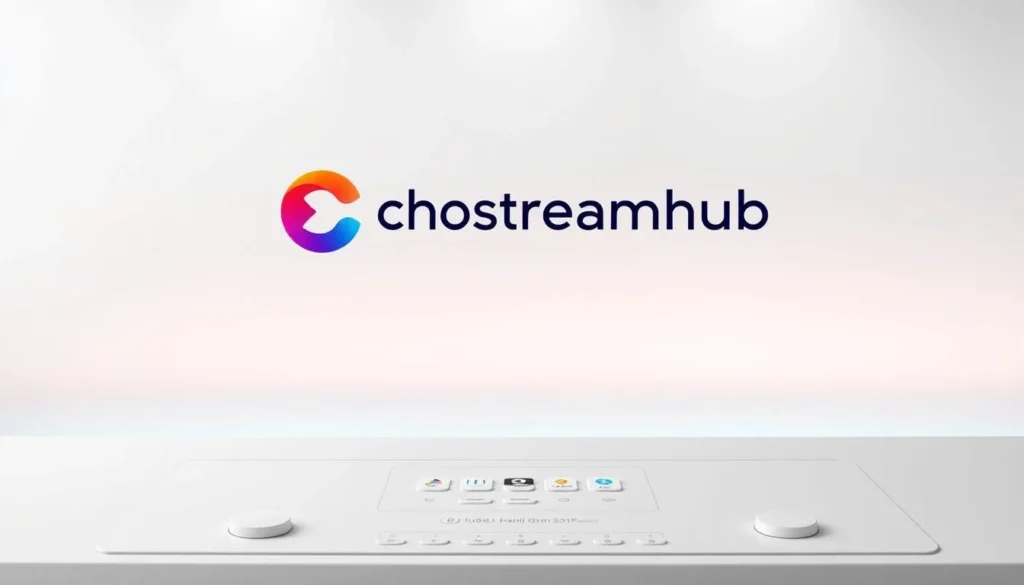Did you know a single live stream can reach viewers on five major sites at once and triple your real-time engagement? That scale changes how you plan and run shows, whether you teach, market, or build a brand.
You need a browser-based platform that removes app juggling and keeps your audience focused. echostreamhub gives you a single dashboard with multi-platform streaming, a content library, and live analytics so you can manage broadcasts from one place.
Built-in tools like multi-chat, polls, and Q&A turn passive viewers into active participants. Creators and businesses benefit from branding controls, overlays, and secure storage to protect your assets and polish every stream.
In the following sections, you’ll see core features, pricing tiers, and security measures that make production smoother and more reliable for teams of any size.
Ultimate Guide Overview: How Echostreamhub Simplifies Streaming in the Present
A single control panel can turn a scattered streaming workflow into a focused strategy that scales. This guide maps how echostreamhub centralizes multi-platform distribution, content hosting, branding, analytics, and audience engagement tools into one browser-based dashboard.
You’ll get a clear roadmap so you can jump to sections that match your goals, whether you’re building a content library, running live events, or improving engagement. The platform reduces the need for three or four separate tools by letting you connect destinations via API or RTMP and schedule broadcasts from one place.
Integrated chat, polls, and Q&A live inside the dashboard, which saves time and cuts errors when you switch platforms during production. Real-time analytics show performance by platform so you can see which formats and audiences respond best right now.
Throughout the guide, you’ll find practical strategy steps that translate features into actions. Learn how to plan for spikes in viewership, segment content across platforms, and use consistent KPIs to measure success for users and business teams alike.

What Is Echostreamhub? Your Unified Streaming and Content Hub
Stream, store, and manage video from a single web dashboard without installing extra software. This browser-based platform blends live streaming, video hosting, content management, and audience engagement into one cohesive system you control from any device.
You connect to YouTube, Twitch, Facebook, LinkedIn, and custom RTMP destinations. Built-in chat, polls, Q&A, reactions, and customizable overlays keep interactions native to your broadcast instead of patched together across apps.
The content library stores replays and gated content so creators and businesses organize on-demand assets and control access. Per-platform analytics let you see which topics, lengths, and formats resonate with each audience.
Use cases range from webinars and trainings to interactive classes and community streams. The tool reduces the complexity of shifting from live to on-demand workflows and replaces piecemeal setups with a single, scalable ecosystem.
Imagine controlling every broadcast and chat from one browser tab, so you spend less time switching tools and more time creating. This product groups live streaming, overlays, and moderation into a single, accessible dashboard you open from any device.
You get built-in engagement features — chat, polls, Q&A, and reactions — so users see and join conversations without jumping platforms. Those same tools make moderation easier and reduce missed messages during fast-paced shows.
Real-time analytics surface data about viewers, topics, and timing so you can make confident content decisions on the fly. Privacy is handled with end-to-end encryption and secure storage, keeping access controlled across destinations.
Options range from a free tier for testing to Pro for growth and Enterprise for white-label and API needs. The result is a browser-based product that trims context switching, lowers error risk, and keeps your team focused on quality streaming.

How Echostreamhub Works: From Dashboard to Live Event
A fast, centralized workflow turns setup into minutes instead of hours so you stay focused on the event. You connect your platforms in minutes using built-in API flows or RTMP keys and broadcast to multiple platforms from one dashboard.
Configure scenes, overlays, and audio/video sources once, then reuse layouts to speed management for recurring shows. That setup reduces mistakes and frees your team to polish content and delivery ahead of showtime.
Schedule broadcasts and pre-publish announcements to buy time for promotion. During the event, centralize engagement tools so you handle chats, polls, and Q&A without hopping across tabs.
Follow a setup checklist to lock in stable encoding, sources, and assets. Real-time data streams into the dashboard so you can call out viewers, adjust pacing, and push CTAs based on live metrics.
Advanced features like per-platform analytics and custom RTMP destinations expand reach while keeping management simple. The platform organizes pre-show assets, live recordings, and highlights so you spend less time on tool orchestration and more time on the event itself.
Getting Started: Step-by-Step Setup and First Stream Checklist
Start streaming confidently with a step-by-step checklist that keeps your setup tidy and repeatable.
Create your account, then connect destinations like YouTube, Twitch, Facebook, LinkedIn, or a custom RTMP. Verify stream keys so your broadcast routes correctly across platforms.
Use the dashboard to configure base scenes, add logo overlays, and set transitions. These small branding choices make your content look consistent from the first frame.
Enable integrated chat and run private q&a sessions to confirm moderation roles and timing. A timed rehearsal helps you check audio levels, browser permissions, and upstream bandwidth before you invite viewers.
Review plan options to meet your immediate need: Free supports two platforms, Pro unlocks unlimited destinations and advanced branding, and Enterprise adds white-label and API access.
Before going live, schedule the stream, add a thumbnail, craft a clear description, and set a backup RTMP path for redundancy. Follow a short user-first checklist to catch muted sources or wrong resolution settings.
Mastering the Dashboard: Control, Management, and Team Workflows
Your dashboard is the nerve center for live shows, giving clear control over scenes, chats, and timing.
Organize panels for quick access to scenes, destinations, and monitoring. This keeps your workspace clean and reduces mistakes during live runs.
Set roles and permissions so users can handle chat moderation, graphics switching, or analytics without stepping on each other. Pro and Enterprise tiers add multi-user access and white-label options for business teams.
Use built-in features like reusable templates, scene presets, and asset folders to keep content consistent. Save layouts for recurring shows and speed up setup.
Coordinate handoffs: producers take live control while speakers focus on delivery and audience interaction. Integrated tools cut friction—fewer windows and faster responses—so the team sees what matters in the moment.
Filter data views per platform and session to highlight KPIs. Customize the workspace, name assets clearly, version files, and keep backups so your management stays scalable and reliable.
Broadcast to Multiple Platforms Without the Juggle
Going live on multiple platforms expands reach without multiplying your workload. You connect once and stream simultaneously to YouTube, Twitch, Facebook, LinkedIn, and custom RTMP destinations.
That single workflow means you meet your audience and viewers where they already spend time. You manage scenes, overlays, and CTAs from one dashboard instead of repeating the same steps for each platform.
Use per-platform filters in real-time analytics to watch performance by channel. Spot spikes in chat, retention drops, or platform-specific watch time and make live fixes that improve your live events.
Integrated tools aggregate messages so moderation stays fast even when concurrency surges. Tailor captions, titles, and thumbnails to each destination without re-editing your master feed.
Whether you’re launching, teaching, or demoing, this approach scales discovery and conversions. Businesses combine owned channels with social endpoints to maximize reach while keeping operations lean.
Audience Engagement That Drives Results
Real-time interaction changes broadcasts into two-way conversations that drive results. Use built-in engagement tools like multi-platform chat, live polls, emoji reactions, on-screen comments, and q&a sessions to turn passive viewers into active participants.
Manage those audience engagement tools from one dashboard so you never miss a question during busy moments. Highlight comments, pin poll results, and run timed CTAs to guide users toward downloads, sign-ups, or calendar adds.
Experiment with prompts, pacing, and segment transitions to boost interaction. Measure engagement rates and session duration with live analytics so you can repeat what works and cut what doesn’t.
Capture feedback in real time to shape future shows — topic choices, guest picks, or format tweaks. Establish clear moderation roles and safety practices to keep the conversation lively and respectful while protecting your community.
Real-Time Analytics: Data to Refine Your Strategy
Real-time numbers turn guesswork into action, so you can optimize content as it airs. The dashboard shows platform-specific viewer counts, engagement rates, watch time, and session duration in clear panels.
You filter by destination to compare platforms side-by-side. That view helps you spot which topics and formats win with viewers and why.
Use watch time and session duration to refine pacing, hooks, and mid-roll CTAs. You’ll also see which features and layouts drive the most engagement so you can repeat winning patterns.
This data helps marketers focus budgets on channels that convert after live sessions. Export reports to your analytics tools, add findings to recap decks, and update your editorial calendar fast.
During a show, configure the dashboard to surface leading indicators in real time. Benchmark against past streams to measure retention improvements and build a repeatable strategy across platforms.
Content Library and On-Demand Management
Your on-demand library should work as hard as your live shows, turning past streams into evergreen assets. Upload recordings, tag clips, and group materials so you reuse highlights and full replays without hunting for files.
Organize content into collections and playlists that match courses, series, or campaigns. Use metadata and tags to keep large libraries discoverable for users and teammates.
Control privacy and permissions for customers, students, or partners while keeping a public hub for discovery. Secure storage and role-based access protect sensitive materials across the platform.
Creators and businesses benefit from browser-based tools that generate on-demand versions right after a live session. That removes exports and speeds approvals and updates for distributed teams.
Link library insights to future programming so your most-watched content shapes what you produce next. Whether ’re scaling a course library or building a brand resource center, this management flow keeps assets useful and easy to find.
Branding and Customization: Make Every Stream On-Brand
Your stream’s look matters — consistent branding keeps viewers engaged and remembered. Use custom overlays, lower-thirds, transitions, and logo treatments to give each broadcast a distinct identity.
Set branding presets so every show and replay keeps the same look without rebuilding layouts. The platform supports sponsor placements and co-branded events so your business partners appear polished and native to the show.
Keep assets tidy with a user-friendly library and naming standards. That management practice lets teams pull the right file fast and reuse design elements across series and campaigns.
Choose Pro when you want stronger customization and real-time metrics. Step up to Enterprise for white-labeling, deeper control, and advanced features for multi-user workflows.
Balance polish with speed: templates shorten setup time, while governance rules keep brand use consistent. Track how branded elements affect retention and iterate until your content and tools drive measurable recall.
Security, Privacy, and Reliability You Can Trust
A reliable platform pairs encryption, redundancy, and governance so you can focus on the show.
The system uses end-to-end encryption to protect streams and keep sensitive data confidential. Permissions let you restrict access to events, folders, and recordings so only authorized users can view or download assets.
Redundancy and failover paths preserve performance during traffic spikes. Built-in backups and documented failover steps reduce the chance of downtime for critical broadcasts.
Routine updates and active monitoring drive consistent uptime. You’ll follow a short security checklist before each show to verify keys, roles, and access settings.
Set retention policies for recordings and logs to meet internal rules and external regulations. Plan for limitations by keeping secondary RTMPs, local backups, and a stakeholder contingency plan ready.
In practice, these controls give you predictable performance, clear privacy controls, and a practical path to manage risks during live events on echostreamhub.
Pricing and Plans: Free, Pro, and Enterprise Options
Choose a plan that matches how you use streaming tools today and where you want to grow tomorrow.
The Free tier supports two platforms, basic customization, and limited analytics. It’s a low-risk way for creators to validate content and test audience fit without a steep commitment.
Pro removes destination limits and adds advanced branding, real-time metrics, and multi-user access. This plan suits businesses and growing teams that need collaboration, stronger control over looks, and live data to guide decisions.
Enterprise provides API access, full customization, team collaboration, and white-label capabilities. It’s built for organizations that require integration, large user counts, and branded experiences at scale.
echostreamhub offers transparent inclusions across tiers so essential features aren’t hidden behind add-ons. Factor in users, collaboration needs, and sponsor or white-label triggers when you plan upgrades.
Consider product value beyond line items: reduced setup time, fewer third-party fees, and community feedback on reliability help estimate ROI and payback. Map upgrade triggers like audience size or sponsor demands and you’ll avoid overbuying as you scale.
Integrations and Ecosystem: Tools You Already Use
Connect the apps you already use so your stream fits existing workflows instead of forcing a rebuild.
You’ll link tools like OBS and Zoom with simple stream keys or API flows so capture and meetings feed straight into the broadcast. That keeps your production setup familiar and fast to deploy across devices.
Collaboration stays tight with Slack and Trello integrations. Use them to sync run-of-show notes, approvals, and task handoffs without copying items between systems.
Secure connections and encryption protect data handoffs. Platform APIs keep automation clean so you route insights into CRMs or analytics tools without extra exports.
Enterprise plans extend capabilities with white-label and custom API endpoints. These advanced features let your business tailor the ecosystem while preserving existing tool chains for users.
Whether ’re scaling slowly or quickly, the setup helps you add platforms and features without breaking workflows. Push dashboards to producers and reports to stakeholders so data lands where it belongs.
Performance Under Pressure: Stability at Scale
When audience size spikes, your stream needs an architecture that keeps every frame and chat message steady.
The platform is built with layered redundancy so streams stay consistent during high-traffic live events. Servers, encoder failovers, and geographic routing reduce single points of failure.
You monitor data signals in real time from the dashboard. That visibility lets you adjust bitrate, routing, or call in backup RTMPs without dropping quality.
Users report meaningful feedback: setup time falls and production becomes simpler because you manage sources in one place instead of juggling tabs. That saves time and lowers stress for crews.
Apply clear event runbooks that anticipate surges in chat and interaction. Align roles so producers, moderators, and engineers know who acts when volume peaks.
Rehearse failover steps and backup routes before business-critical sessions. These drills preserve continuity if conditions shift during a live event.
After the show, use post-event analytics to confirm stability metrics and spot improvement areas. That loop of data and rehearsal helps you scale with confidence.
Limitations and Workarounds: What to Know Before You Go Live
Every streaming setup has limitations; knowing them before you go live saves time and stress.
Expect a short learning curve—most teams need about three to five days to feel comfortable. Schedule planned rehearsals and use step-by-step tutorials so your crew learns the tool without scrambling on show day.
Some integrations may be fewer than larger incumbents. Where native links are missing, bridge gaps with RTMP or API connections and test those paths in private meetings or small trials.
Support response can slow at peak times. Build internal SOPs, escalation paths, and checklists so your team can act fast even if vendor help takes longer than you’d like.
Use community playbooks and short test sessions to validate layouts, captions, and third-party sync. Clarify who owns each task so the user experience stays smooth if issues arise.
Track recurring limits and decide when you need plan upgrades or new workflows. With rehearsals, clear roles, and simple backups, you protect shows and keep viewers happy.
Use Cases and Strategies for Creators, Businesses, and Educators
When you match format to audience, your live events and on-demand content perform better across platforms.
Creators can simulcast gameplay or shows to YouTube and Twitch while building community through integrated chat and reactions. Use community-first pacing and repeatable segments to turn casual viewers into loyal followers.
Educators stream lectures to LMS portals and public channels at once. Publish replays to your on-demand library so students access lessons on their schedule and you track completion with data-driven markers.
For businesses, design webinars and product demos with on-brand overlays, clear CTAs, and follow-up assets. Capture leads during the event and push replays into a post-event nurture sequence.
Connect engagement tools to measurable objectives: polls for feedback, Q&A for qualification, and chapters for easier consumption. Use analytics to pick platforms and event formats that match buyer stages and audience behavior.
Plan pre-show meetings, run-of-show docs, and guest prep to keep delivery tight. After the event, review watch patterns and convert insights into the next content strategy for better results.
Conclusion
Bring everything together so your production, promotion, and post-show work as one system. This conclusion gives you clear steps to act on the guide’s ideas.
You’ll see how a single platform reduces the number of tools you use and shortens setup time. Focus on audience engagement and analytics to shape better programming and stronger results for marketers and creators.
echostreamhub offers scalable plans, secure streaming, and familiar integrations that fit into your existing stack. Start with a rehearsal, assign roles, measure engagement quality, and publish replays to build momentum.
Use the checklist here to evaluate success beyond raw views: retention, interaction, and conversions. With this approach you’ll feel ready to adopt a unified tool and improve every broadcast from day one.

